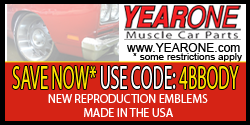nmb0003
Active Member
Looking for help from the experts.
Finishing the engine build for my 68 Charger. Originally a factory-AC, PS, 383 4bbl non-hi po car. Original engine was long gone when I bought it.
I believe I still have the original radiator in it. 26” wide, with pictures of the part number below.
My question is: this radiator has the inlet and outlet BOTH on the passenger side.
Purchased an aluminum water pump housing and noticed it’s drivers side exit. Researching this, seems there was a passenger side exit housing but what I read it was for RV-use only. However from an old 440 core that supposedly came from a ‘74 New Yorker, it has a passenger exit pump housing.
What is correct for my car? Does the water pump need to exit on the drivers side and the rubber house routes it to the passenger side bottom?



Finishing the engine build for my 68 Charger. Originally a factory-AC, PS, 383 4bbl non-hi po car. Original engine was long gone when I bought it.
I believe I still have the original radiator in it. 26” wide, with pictures of the part number below.
My question is: this radiator has the inlet and outlet BOTH on the passenger side.
Purchased an aluminum water pump housing and noticed it’s drivers side exit. Researching this, seems there was a passenger side exit housing but what I read it was for RV-use only. However from an old 440 core that supposedly came from a ‘74 New Yorker, it has a passenger exit pump housing.
What is correct for my car? Does the water pump need to exit on the drivers side and the rubber house routes it to the passenger side bottom?















